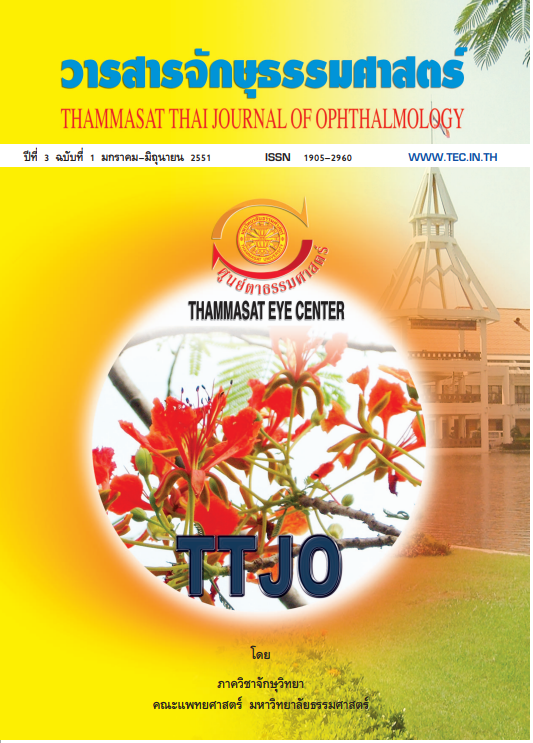What Should We Detect for Preschool Visual Screening?
Main Article Content
Abstract
Article Details
References
Simons K. Preschool vision screening: rational,
methodology and outcome. Surv Ophthalmol
;41:3-30.
Ehrlich M, Reinecke R, Simons K. Preschool
vision screening for amblyopia and strabismus:
Programs, method and guidelines, 1983.
Surv Ophthalmol 1983;286:145-63.
Report on the National Eye Instituteûs Visual
Acuity Impairment Survey Pilot Study.
Bethesda. MD: Office of biometry and
epidemiology. NEI. NIH. PHS. DHHS. 1984.
Pediatric Eye Disease Investigator Group..A
randomized trial of atropine vs. patching for
treatment of moderate amblyopia in children.
Arch Ophthalmol 2002;120(3):268-78.
Committee on Practice and Ambulatory Medicine,
Section on Ophthalmology. American Association
of Certified Orthoptists; American Association
for Pediatric Ophthalmology and Strabismus;
American Academy of Ophthalmology.
Eye examination in infants, children, and
young adults by pediatricians. Pediatrics
;111(4 Pt 1):902-7.
Donahue SP. Chapter 8. Screening. Pediatric
Ophthalmology and Strabismus, third edition;
-5.
American Academy of Pediatrics, Committee
on Practice and Ambulatory medicine. Recommendations
for preventive pediatric health
care. Pediatrics 1995;96:373-4.
Donahue SP, Arnold RW, Ruben JB; AAPOS
Vision Screening Committee. Preschool vision
screening : what should we be detecting andhow should we report it? Uniform guidelines
for reporting results of preschool vision screening
studies. J AAPOS 2003;7(5):314-6.
Miller JM, Harvey EM. Spectacle prescribing
recommendations of AAPOS members. J
Pediatr Ophthalmol Strabismus 1998;35(1):
-2.
Donahue SP, Johnson TM, Leonard-Martin
TC. Screening for amblyogenic factors using
a volunteer lay network and the MTI
photoscreener. Initial results from 15,000
preschool children in a statewide effort.
Ophthalmology 2000;107(9):1637-44; discussion
-6.
Committee on Practice and Ambulatory
Medicine and Section on Ophthalmology;
American Academy of Pediatrics. Use of
photoscreening for childrenûs vision screening.
Pediatrics 2002;109(3):524-5.
Tong PY, Enke-Miyazaki E, Bassin RE, Tielsch
JM, Stager DR Sr, Beauchamp GR, Parks MM.
Screening for amblyopia in preverbal children
with photoscreening photographs. National
Childrenûs Eye Care Foundation Vision Screening
Study Group. Ophthalmology 1998;105(5):
-63.
Ottar WL, Scott WE, Holgado SI. Photoscreening
for amblyogenic factors. J Pediatr
Ophthalmol Strabismus 1995;32(5):289-95.
Holgado SI, Arfeli S, Gomez-Demmel E,
Espinosa J. Comparative study of the MTI
photoscreener, visual acuity and Lang
stereopsis test for amblyogenic factors in
mentally delayed children. Am orthoptic J
;48:122-30.
Cordonnier M, Dramaix M. Screening for
refractive errors in children: accuracy of the
hand held refractor Retinomax to screen for
astigmatism. Br J Ophthalmol 1999;83(2):
-61.


